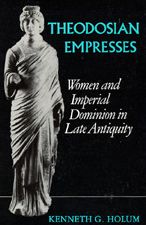Theodosian Empresses:
Women and Imperial Dominion
in Late Antiquity

Kenneth G.
Holum is Professor of History at the University of Maryland
At the end
of the book we have a bibliography and an index. References to ancient sources
and modern works are given in footnotes (not endnotes).
There are
19 illustrations, 12 of which are coins. Every coin has two sides: obverse and
reverse. In this book both sides are shown. When there are 12 coins, it means
there are 24 pictures. There is also a statue of an Augusta Augusta Augusta
In
addition, we have a plan of Constantinople and a genealogical table (a family
tree). Finally, we have a detail of a large silver disc discovered in Spain Trier
The
illustrations are well-chosen, but unfortunately they are only in
black-and-white. It is a shame. If you are going to look at a picture of gold
coin, you can see so much more if the picture is in colour.
Holum likes
to show off his considerable erudition: in the footnotes he quotes from French
and German scholars in the original language. Greek and Latin sources are also quoted
in the original language. Why? I think the reason is that this book began its
life as a Ph.D. dissertation for the University of Chicago
Eventually,
the dissertation was turned into a published book, but it seems that many of
the original footnotes were kept intact. In the main text, however, Greek and
Latin quotes are usually translated into English. Three of the seven chapters
are divided into three sections by two subheadings. In this way they are more
reader-friendly. But four chapters do not have any subheadings. This is old-style
writing and publishing: each time there are about 30 pages without a single
break!
In this
book the focus is on four Theodosian empresses: Flacilla, Eudoxia, Pulcheria,
and Eudocia, who reigned in the east. Each empress gets one chapter. As Holum
says on page 3, “These were indeed a colorful lot, and their careers merit
detailed investigation.”
While I
agree, I would like to ask: what about Galla Placidia? She was also a
Theodosian empress, although she was from the west. She had a most dramatic and
turbulent life, but in this book she is only mentioned in passing. She does not
get her own chapter, as the other four empresses do. This is a shame.
[See Hagith Sivan, Galla Placidia: The Last Roman Empress, 2011.]
Holum’s
account is based on a hypothesis: the Theodosian empresses were not only part
of the imperial family, they ruled the empire. Holum thinks his hypothesis is
confirmed. On page 3 he says: “Ultimately, these women did achieve authentic
imperial dominion.”
I do not
agree. Instead of a hypothesis, it might be more useful to ask some questions:
(1) Were the Theodosian empresses part of the imperial power structure? (2)
Were they sometimes able to get their way? (3) Did they rule the empire?
While the
answer to question 1 and 2 is yes, the answer to question 3 is no, and Holum himself
provides the evidence: when an empress was able to get her way, there was
usually some kind of trick involved, such as the episode in 402 when an infant emperor
(Theodosius II) granted a petition (page 55). His father Arcadius later accepted
the decision because “the lady empress nagged him incessantly.”
Chapter V
is about Nestorius, who was bishop of Constantinople 428-431, and the church council in Ephesus Constantinople and to insult the empress Pulcheria
as well. In order to solve the escalating conflict the emperor called a church
council in Ephesus
The
important players arrived with a large group of followers who tried to
intimidate their opponents. The council was a farce: one council reached one
decision. Then a counter-council reached the opposite decision. Since the
bishops could not agree, the emperor would have to decide. He had hired
Nestorius in 428, and he stood by him all the way, but in 431 he realised that
he had to go. According to Holum, this is proof of his hypothesis (page 147): “Remarkably,
Pulcheria defeated both the bishop and her brother the emperor.” The phrase
“Pulcheria’s victory at Ephesus
I do not
agree. We have to ask some questions here: why did this happen? Was it because
of something that she did? Or because of something someone else did? As Holum himself
shows, many other elements wanted the same outcome as she did. We cannot know
how much or even if Pulcheria contributed to the downfall of Nestorius. He
might have been fired even if Pulcheria never said a word about him and never did
a thing to oppose him. While Holum believes this episode shows that Pulcheria
exercised real power, I think it is a case of wishful thinking.
Holum has
written an interesting book about the four Theodosian empresses who reigned in
the east. But he forgot one Theodosian empress who reigned in the west, and the
structure of the book – seven long chapters with very few subheadings – is a
bit old-fashioned. Sometimes the going gets a bit tough. Moreover, the
illustrations are only in black-and-white, and in spite of what the author claims,
his hypothesis is not confirmed.
* * *
Kenneth G. Holum, Theodosian Empresses:
Women and Imperial Dominion in Late Antiquity,
University of California Press (1982, 1989), 258 pages
Women and Imperial Dominion in Late Antiquity,
University of California Press (1982, 1989), 258 pages
No comments:
Post a Comment